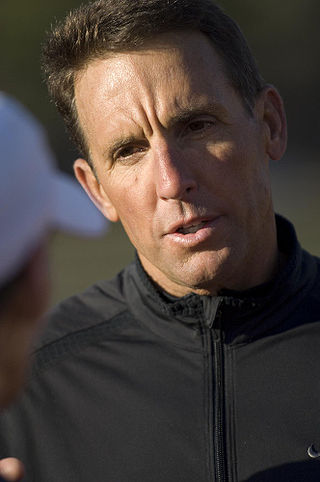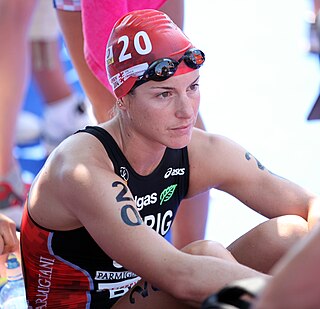
A triathlon is an endurance multisport race consisting of swimming, cycling, and running over various distances. Triathletes compete for fastest overall completion time, racing each segment sequentially with the time transitioning between the disciplines included. The word is of Greek origin, from τρεῖς or treis (three) and ἆθλος or athlos (competition).

An Ironman Triathlon is one of a series of long-distance triathlon races organized by the World Triathlon Corporation (WTC), consisting of a 2.4-mile (3.9 km) swim, a 112-mile (180.2 km) bicycle ride and a marathon 26.22-mile (42.2 km) run completed in that order, a total of 140.6 miles (226.3 km). It is widely considered one of the most difficult one-day sporting events in the world.
Due to the nature of triathlons as a race consisting of multiple sports many pieces of technical equipment have been borrowed from other sports, or developed specifically in an effort to race faster and improve a competitors safety.

An aquathlon is a multisport race consisting of continuous run and swim elements. Competitors complete a swim immediately followed by a run over various distances. Athletes compete for fastest overall course completion, including the time transitioning between the disciplines.

Cross triathlon, or off-road triathlon, is a form of triathlon, or three-stage race, consisting of a swim stage, mountain-biking stage, and a trail-running stage.
The San Diego Creek bicycle path is a cycling route in the city of Irvine, California. The path connects major points such as Newport Beach, University of California, Irvine, Boomers Irvine, Colonel Bill Barber Park, Irvine Civic Center, Irvine Crossroads shopping center, Woodbridge High School, Woodbridge Community Park, Atria Senior Residential Area, Windrow Community Park and Irvine Medical Complex, before reaching Irvine Spectrum Center. It also runs through the majority of Irvine's neighborhoods such as Westpark, Woodbridge, and Oak Creek. The path begins where the San Diego Creek empties into Upper Newport Bay.
Ironman 70.3 SuperFrog is a half-Ironman triathlon held annually and based on the Silver Strand State Beach, Coronado, California.

Escape from Alcatraz is the name for two different triathlons held in the San Francisco Bay Area of California. The Escape from Alcatraz originated in 1981 as a private club event, beginning in San Francisco and ending in Marin County. The race split in 1983 with a separate commercial event open to the public, which is now an aquathlon held on a shorter course entirely within San Francisco. However, a new public triathlon, also known by the name Escape from Alcatraz, is now run by IMG.

Lake San Antonio is a lake located primarily in southern Monterey County, California, and partially in northern San Luis Obispo County, California. The lake is formed by San Antonio Dam on the San Antonio River. The dam is 202 feet tall and was completed in 1965 under Monterey County District Engineer Loran Bunte Jr. The lake and dam are owned by the Monterey County Water Authority. The lake has a capacity of 350,000 acre-feet (430,000,000 m3).
An Ironman 70.3, also known as a Half Ironman, is one of a series of long-distance triathlon races organized by the World Triathlon Corporation (WTC). The "70.3" refers to the total distance in miles (113.0 km) covered in the race, consisting of a 1.2-mile (1.9 km) swim, a 56-mile (90 km) bike ride, and a 13.1-mile (21.1 km) run. Each distance of the swim, bike, and run segments is half the distance of that segment in an Ironman Triathlon. The Ironman 70.3 series culminates each year with a World Championship competition, for which competitors qualify during the 70.3 series in the 12 months prior to the championship race. In addition to the World Championship race, Ironman 70.3 championship competitions are also held for the European, Asia-Pacific, and Latin America regions.

Dave Scott is a U.S. triathlete and the first six-time Ironman World Championship winner. A progenitor of the sport, in 1993, Scott was the first person ever inducted in the Ironman Hall of Fame. He is known by the nickname "The Man" for his intense training regimens and his unrelenting race performances that created a record number of wins.
An indoor triathlon is a nonstandard variation of the triathlon and consists of three events: swimming, cycling, and running. The swim is held in an indoor pool, the cycling takes place on stationary bikes, and the run takes place on an indoor track or treadmill. Indoor triathlons are generally held in fitness clubs to accommodate all three sports.
The Dextro Energy Triathlon – ITU World Championship Series 2011 was a series of six World Championship Triathlon events leading to a Grand Final held in Beijing, China in September 2011. The Series was organised under the auspices of the world governing body of triathlon, the International Triathlon Union (ITU), and was sponsored by Dextro Energy.

The triathlon events at the 2012 Summer Olympics were held in Hyde Park in London, United Kingdom, with the women's triathlon held on 4 August and the men's on 7 August. 110 triathletes from 39 countries competed with 55 men and 55 women competing. The races were held over the "international distance" and consisted of 1.5 kilometres (0.93 mi) swimming, 43 kilometres (27 mi) road cycling, and 10 kilometres (6.2 mi) road running.

The men's triathlon was one of the triathlon events at the 2012 Summer Olympics in London, United Kingdom. It took place on 7 August 2012, featuring 55 men from 32 countries. It was the fourth appearance of an Olympic men's triathlon event since the first at the 2000 Olympics in Sydney. The race was around Hyde Park, a 1.42 km2 park in central London. The race was held over the "international distance" and consisted of 1.5 kilometres (0.93 mi) swimming, 42.959 kilometres (26.693 mi) road cycling, and 10 kilometres (6.2 mi) road running.

The women's triathlon was one of the triathlon events at the 2012 Summer Olympics in London, United Kingdom. It took place on 4 August 2012, featuring 55 women from 31 countries. It was the fourth appearance of an Olympic women's triathlon event since the first at the 2000 Olympics in Sydney, Australia. The race was around Hyde Park, a 1.42 km2 park in central London. The race was held over the "international distance" and consisted of 1.5 kilometres (0.93 mi) swimming, 43 kilometres (27 mi) road cycling, and 10 kilometres (6.2 mi) road running.
The World Triathlon Championship Series is World Triathlon's annual series of triathlon events used to crown an annual world champion since 2008. There are multiple rounds of competitions culminating in a Grand Final race. Athletes compete head-to-head for points in these races that will determine the overall World Triathlon champion. The elite championship races are held, with one exception, over two distances, the standard or 'Olympic' distance and the sprint distance. The ITU world champion between 1989 and 2008 had been decided in a single annual championship race.

The Triathlon competitions at the 2014 Commonwealth Games, in Glasgow, were held in Strathclyde Country Park. The men's and women's individual events were held on Thursday 24 July and women's triathlon was the first medal event of the Games. Mixed team relay was held on Saturday 26 July for the first time ever in major multi-sport Games. Marisol Casado, ITU President and IOC member, commented: "We are delighted the Glasgow 2014 Organising Committee has embraced the Triathlon Mixed Relay. Triathlon is on currently on a high in the United Kingdom, and the Mixed Relay will offer an extra opportunity for the people of Glasgow to watch another thrilling and unpredictable event live on their city streets."
The Embrunman is a long distance triathlon held on August 15 each year around Embrun in the Hautes-Alpes, France. It is an equivalent triathlon consisting of a swim of 3.8 km, a 186 km cycle ride and running a marathon (42.195 km), but is not affiliated with the World Triathlon Corporation which owns the brand Ironman, so is not promoted as such. The French newspaper Le Dauphiné libéré described it in 2012 as the hardest triathlon in the world. The men's record time for the event is 9 h 28m 18 s by the Frenchman Léon Chevalier on August 15, 2021 and the women's record is held by Carrie Lester from Australia at 10 h 46 m 26 s. The men's record number of victories in this event is held by spanish triathlete Marcel Zamora Pérez with six wins, and women's record by Briton Bella Bayliss Commerford with 3 victories.

The 2019 ITU World Triathlon Series was the 11th season of the World Triathlon Series, the top level international series for triathlon, since its establishment in 2009. The season consisted of eight pairs of triathlon races for both a men's and woman's competition, beginning on 8 March in Abu Dhabi, and concluding on 1 September with the grand final at Lausanne, Switzerland. The season also contained five mixed relays as part of the Mixed Relay Series which offers national teams qualifying points for the mixed team relay event at the 2020 Tokyo Olympics.












